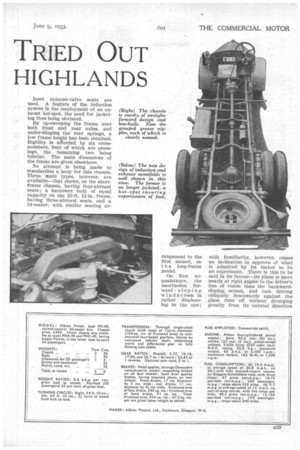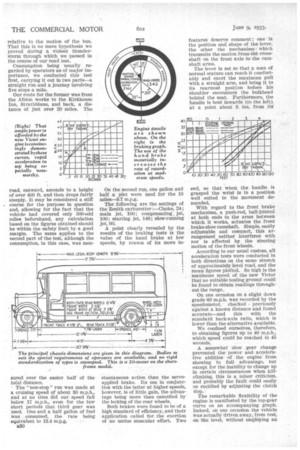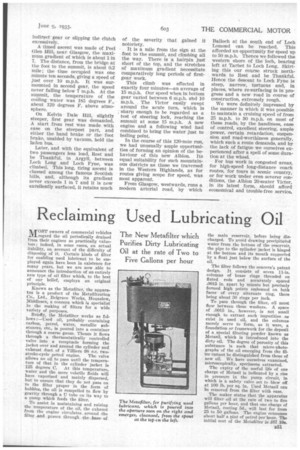AN ALBION Bus
Page 42

Page 43

Page 44

Page 45

If you've noticed an error in this article please click here to report it so we can fix it.
IN THE TRIED OUT HIGHLANDS
AT the beginning of this year Albion Motors, Ltd.i Scotstoun, Glasgow, introduced an improved version of the Victor 20seater passenger chassis, in which was installed a new type of engine of larger capacity and bigger output than that of its predecessor. This model, in the form of a demonstration bus, is the subject, this week, of our road test.
From the accompanying specification table it will be observed that the bore of the new engine is 3i ins., which is .Iin. greater than the old Victor power unit. Its output is 60 b.h.p., as opposed to 42 b.h.p. of the earlier model. The new engine is of simple and robust construction, hay lug side valves, a detachable head embodying the latest design of combustion chamber, and a one-piece cylinder block and top half of the crankcase, the cylinders having dry liners in accordance with the usual Albion practice.
The short, stiff crankshaft runs in three bearings and is drilled for bigend lubrication. Alloy pistons, with two compression and two scraper rings, are employed. Straightforward helical gearing rotates the camshaft, whilst a cross-shaft transmits the drive to the water pump and magneto. A further pinion drives a small dynamo or governor, if required, on the off side of the engine, whilst provision is made for a second and larger dynamo, driven by a chain, on the near side. Inset exhaust-valve seats are used. A feature of the induction system is the employment of an exhaust hot-spot, the need for jacketing thus being obviated.
By up-sweeping the frame over both front and rear axles, and under-slinging the rear springs, a low frame height has been obtained. Rigidity is afforded by six crossmembers, four of which are pressings, the remaining two being tubular. The main dimensions of the frame are given elsewhere.
No attempt is being made to standardize a body for this chassis. Three main types, however, are available—that shown, on the shortframe chassis, having four-abreast seats ; a narrower body of equal capacity on the 22-ft. if in. frame, having three-abreast seats, and a 24-seater, with similar seating ar
With familiarity, however, comes an inclination to approve of what is admitted by its maker to be an experiment. There is this to be said in its favour—its plane is more nearly at right angles to the driver's line of vision than the backwardsloping screen, and rain driving obliquely downwards against the glass runs off without diverging greatly from its natural direction
relative to the motion of the bus. That this is no mere hypothesis we proved during a violent thunderstorm through which we passed in the course of our road test. Consumption being usually regarded by operators as of major importance, we conducted this test first, carrying it out in two parts—a straight run and a journey involving live stops a mile.
Our route for the former was from the Albion works to the Kirkhouse Inn, Strathblane, and back, a distance of just over 20 miles. The
road, outward, ascends to a height of over 400 ft. and then drops fairly steeply. It may be considered a stiff course for the purpose in question and, allowing for the fact that the vehicle had covered only 500-odd miles beforehand, any calculation based on the figures obtained should be within the safety limit by a good margin. The same applies to the second part of the test, although the consumption, in this case, was mea
sured over the easier half of the total distance.
The "non-stop" run was made at a cruising speed of about 30 m.p.h., and at no time did our speed fall below 17 m.p.h., even for the few short periods that third gear was used. One and a half gallon of fuel was consumed, the rate being equivalent to 13.4 m.p.g.
B30 On the second run, one gallon and half a pint were used for the 10 miles-9.7 m.p.g. The following are the settings of the Zenith carburetter :—Choke, 24; main jet, 100; compensating jet, 100; starting jet, 140; slow-running jet, 60.
A point clearly revealed by the results of the braking tests is the value of the hand brake at low speeds, by reason of its more in
stantaneous action than the servoapplied brake. Its use in conjunction with the latter at higher speeds, however, is of little gain, the advantage being more than cancelled by the locking of the rear wheels. Both brakes were found to be of a high standard of efficiency, and their application called for the exertion of no undue muscular effort. Two
featureS deserve comment; one is the position and shape of the lever, the other the mechanism which transmits the motion from the crossshaft on the front axle to the camshaft arms.
The lever is set so that a man of normal stature can reach it comfortably and exert the maximum pull with a straight arm, and bring it to its rearmost position before his shoulder encounters the bulkhead behind the seat. Furthermore, the handle is bent inwards (to the left) at a point about 6 ins, from its end, so that when the handle is grasped the wrist is in a position well suited to the movement demanded, With regard to the front brake mechanism, a push-rod, ball-jointed at both ends to the arms between which it works, actuates the front brake-shoe camshaft. Simple, easily adjustable and compact, this arrangement neither interferes with nor is affected by the steering motion of the front wheels. According to our usual custom, all acceleration tests were conducted in both directions on the same stretch of approximately level road, and the mean figures plotted. So high is the maximum speed of the new Victor that no suitable testing ground could be found to obtain readings throughout the range.. On one occasion on a slight down grade 60 m.p.h. was recorded by the speedometer, checked previously against a known distance and found accurate—and this with the standard back-axle ratio, which is lower than the alternative available. We confined ourselves, therefore, to obtaining figures up to 40 m.p.h., which speed could be reached in 45 seconds. A somewhat slow, gear change prevented the power and accelerative abilities of the engine from showing to full advantage, but except for the inability to change up in certain circumstances when hillclimbing, this is a minor criticism. and probably the fault could easily oe rectified by adjusting the clutch stop. The remarkable flexibility of the engine is manifested by the top-gear curve on an accompanying graph. Indeed, on one occasion the vehicle was actually driven away, from rest, on the level, without employing an
indirect gear or slipping the clutch excessively.
A timed ascent was made of Peel Glen Hill, near Glasgow, the maximum gradient of which is about 1 in 7. The distance, from the bridge at the foot to the summit, is about 0.2 mile ; the time occupied was one minute ten seconds, giving a speed of just over 10 m.p.h. It was surmounted in second gear, the speed never falling below 7 m.p.h. At the summit, the temperature of the cooling water was 185 degrees F„ about 120 degrees F. above atmosphere.
On Kelvin Dale Hill, slightly steeper, first gear was demanded. A start from rest was made with ease on the steepest part, and either the hand brake or the foot brake, unaided by vacuum, held the laden bus.
Later, and with the equivalent of two passengers less load, Rest and be Thankful, in Argyll, between Loch Long and Loch Fyne, was climbed. This long, tiring ascent is classed among the famous Scottish hills, and, although its gradient never exceeds 1 in 7 and it is now excellently surfaced, it retains much of the severity that gained it notoriety.
rt is a mile from the sign at the foot to the summit, and climbing all the way. There is 'a hairpin just short of the top, and the stretches of maximum gradient necessitate comparatively long periods of firstgear work.
This climb was effected in exactly four minutes—an average of 15 m.p.h. Our speed when in bottom gear varied between 6 m.p.h. ahd 10 m.p.h. The Victor easily swept around the acute turn, which is , sharp enough to he regarded as a test of steering lock, reaching the summit at some 15 m.p.h. A new engine and a following wind had combined to bring the water just to boiling point.
In the course of this 120-mile run, we had unusually ample opportunities of forming an opinion of the behaviour of this new Albion. Its equal suitability for such mountainous districts as those we traversed in the Western Highlands, as for routes giving scope for speed, was most apparent.
From Glasgow, westwards, runs a modern arterial road, by which Balloch at the south end of Loch Lomond can be reached. This afforded an opportunity for speed up to 50 m.p.h. Thence we followed the western shore of the loch, bearing left at Tarbet to Loch Long. Skirting this our course struck northwards to Rest and be Thankful. Hence the descent to Loch Fyne is steep, narrow, tortuous and, in places, where re-surfacing is in progress and a new road in course of construction, extremely rough.
We were definitely impressed by the manner in which it was possible to maintain a cruising speed of from 25 m.p.h. to 30 m.p.h. on most of these roads, by the handiness, ease of control, excellent steering, ample power, certain retardation, suspension and road-worthiness generally, which such a route demands, and by the lack of fatigue we ourselves experienced after a spell of some duration at the wheel.
For bus work in congested -areas, for high-speed long-distance coach routes, for tours in scenic country, or for work under even severer conditions, the Albion 20-seater Victor, in its latest form, should afford economical and trouble-free service.




























































































